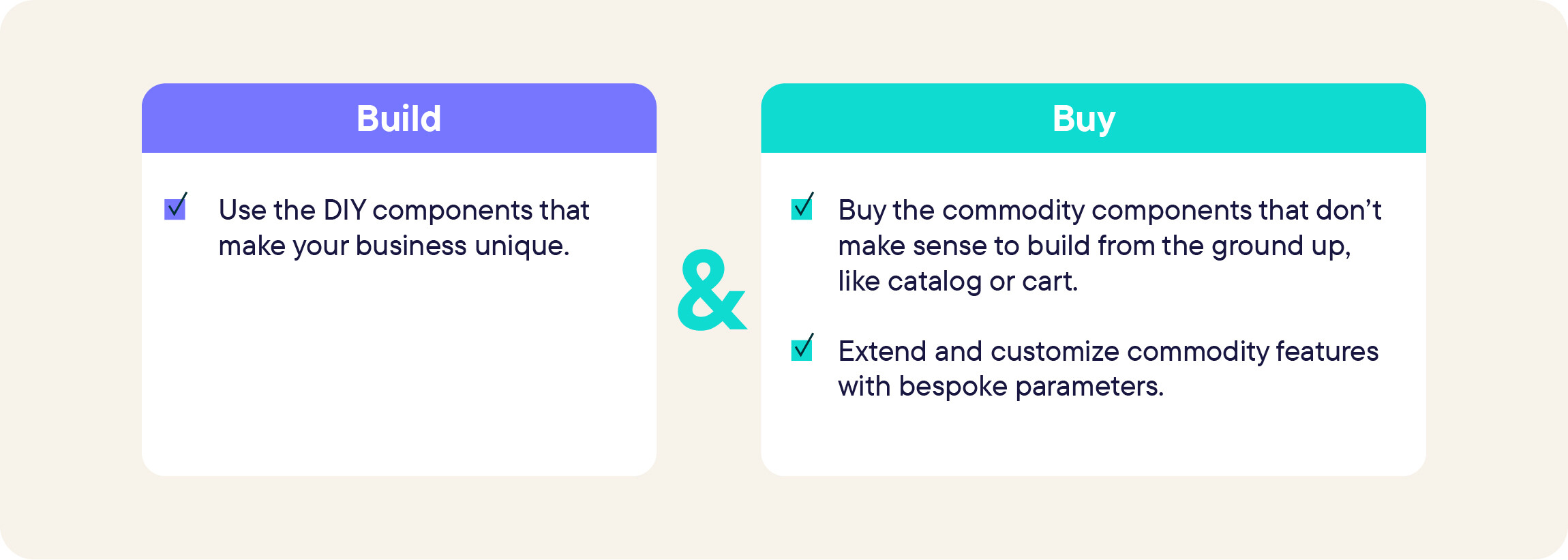
If your B2B business is feeling the pressure to invest in a digital transformation ASAP, composable commerce is the way to do it. Do you have questions on benefits, best practices, and how composable impacts TCO and ROI? Get all the answers here.

What does composable commerce mean for B2B?
B2B Commerce is a component-based design that empowers B2B enterprises to “compose” commerce experiences that speak to their needs and requirements. In other words, composable commerce tackles the inherent complexity of the B2B sector head-on by offering unparalleled flexibility and scalability to manufacturers, distributors and wholesalers, so they can manage complex and unique requirements, such as handling large order volumes, managing multiple pricing tiers and integrating with ERP systems.
Composable solutions provide the ideal balance between providing out-of-the-box features for standard use cases like quoting and business unit-specific pricing, while allowing for extension-based customization. Moreover, a true composable system is more than best-of-breed components and includes three core traits:
It’s also worth mentioning that composability supports a “build-and-buy” approach, which gives B2B firms the ability to integrate commoditized components from best-of-breed solutions that fit their business needs at any given time AND build/customize the bits that reflect the uniqueness of their business. Such capabilities are crucial to tackle B2B’s inherent complexity. As a result, B2B companies are increasingly adopting a composable approach to become digitally mature faster and more cost-effectively.

What are the benefits of implementing a composable commerce strategy for B2B enterprises?
Composable commerce enables enterprises to make consumer-grade experiences in B2B a reality. This approach brings seven top benefits:
Unlimited flexibility and agility. Addressing the inherent complexities of the B2B sector necessitates a fully flexible, scalable and agile approach — the cornerstones of composability.
Infinite scale. Run multiple brands, expand to new markets, bring in new channels and even try out new business models with ease. Respond faster to influxes of traffic and customers with auto-scaling and high SKU processing times.
Automate labor-intensive processes. Automate and optimize processes that currently require extensive manual overhead, like handling complex payment terms, quote generation and reordering.
Reduce total costs of ownership (TCO). As a versionless system, composable commerce eliminates the need for upgrades, maintenance or backward compatibility of customizations. Also, technical debt and hosting fees become a thing of the past. Cloud-native infrastructure eliminates the need to pre-provision and manage servers to handle traffic peaks and reduces hosting costs.
Boost ROI. Create customized journeys to differentiate, accelerate experimentation and innovation to increase market share, and expand to new geographies and even to new business models like D2C, easily.
Reduce downtime risks. The distributed nature of composable architecture reduces the risks of system crashes, as any issues that may arise are easier to contain and fix since the components are decoupled from each other architecturally.
Adaptability and incremental innovation. Designed for constant change, a composable approach enables companies to swap functionalities in and out without friction, as well as reduce time-to-market for new releases.
What are common use cases for composable commerce in B2B?
There’s a wealth of use cases B2B companies can leverage with composable commerce — these are the five most common ones:
Creating a B2C-like experience for B2B buyers
Customer-centric eCommerce experiences are imperative to attracting and retaining business in B2B. With 75% of B2B buying teams comprising buyers aged 25 to 44 in 2024, plus Generation Z entering the workforce, B2B experiences mirroring B2C experiences are now imperative.
The younger clients at Dawn Foods began requesting a new digital ordering process and catalog. After migrating to commercetools B2B Commerce, Dawn Foods’ customers can see their order history, pick the order and then reorder. In only three clicks, the order is done. This B2C-like strategy has brought fantastic results: 25% of all orders are now processed online with a higher average order value (AOV). Also, nearly all orders placed online include products that customers haven’t bought before, reflecting the successes of a digitized product catalog with optimized product discovery capabilities.
Expanding to new business models
B2B manufacturers have found synergies with the D2C (direct-to-consumer) model to open new revenue streams. To execute this strategy, B2B firms need a unified commerce platform encompassing all business models, capitalizing on crucial data synergies across products, catalogs, inventory and checkout. This also avoids extra costs spent with disparate platforms.
The European subsidiary of the world-class manufacturer of camera lenses, Tamron Europe, created a dedicated webshop for growing consumer demand. With a D2C channel powered by composable commerce, photography aficionados can buy directly from the camera lens company.
Similarly, the power tools manufacturer Festool decided to go D2C all-in as a route to own customer relationships and data. This strategy became increasingly important for the company as a significant portion of customers preferred to purchase directly from the manufacturer, instead of visiting a marketplace or a specialized retailer website. Since adopting a composable approach, Festool set an incredible path for global growth, entering 39 new markets and achieving 150% of internal sales goals in its first year.
Configurable and scalable product catalogs
Composable commerce provides B2B players tremendous flexibility to create intuitive product discovery experiences, no matter how extensive the product catalog is.
The leading Indian conglomerate JSW Group benefits from a flexible product catalog that is scalable enough to support millions of product variations and configurations by weight, grade and length. TROX, a components supplier for room ventilation and air conditioning, has a similar case: Thanks to composable commerce, the company created a sophisticated product finder and configurator that supports up to 30 million possible configurations.
Furthermore, Zoro.com, a pure-play digital distributor of tools and business supplies, leverages composable commerce to keep track of all orders, carts and intermediate states for the company, which handles an impressive number of SKUs in real-time.
Automation and hybrid sales
With the inherent component-based approach of composable commerce, it’s easy for B2B enterprises to automate common processes like quote generation, orders, inventory management and fulfillment, as well as customer-specific pricing and promotions. This also enables to reduce manual administrative operations, automate the sales process and enable hybrid sales.
After transporting its vast product catalog into the digital realm, the underground mining company Normet started to automate operations and sales. With a B2B eCommerce platform, the company pivoted from manual to digital processes, boosting a hybrid sales approach.
International expansions
Composable commerce enables B2B enterprises to expand to new countries easily. With a flexible and agile infrastructure, you can manage new languages, currencies and localization features without missing a beat.
The water-based solutions manufacturer Orbia Wavin rolled out 35 localized webshops to serve regional merchants across Europe, Latin America and APAC, a milestone achieved thanks to the digitization of an extensive product catalog with commercetools’ APIs, creating one source of product information across all of its markets.
What are the best practices for implementing a composable commerce solution for B2B enterprises with a fast time to value?
B2B players investing in digital commerce with composable stacks can maximize their results with the following best practices:
Pre-composed solutions accelerate time to value
Pre-composed solutions such as commercetools Foundry Blueprint for B2B Manufacturing provide a pre-configured set of components, features, best practices and launchpads, simplifying the path of composable implementations.
Pre-built integrations speed up time to market
Simplifying integrations in a composable environment is critical for success. With pre-built connectors, vetted and hosted on commercetools, you can expedite your eCommerce launch.
Harness data management and analytics with flexible data models
Flexible data models powered by a composable approach empower you to easily handle, edit and orchestrate multiple data scenarios, attributes, locations and relationships without affecting performance.
Manage all things commerce with a no-code UI
Low- and no-code tools, such as the Merchant Center, enable marketers, content managers and other business users to have a more active role in digital commerce initiatives through easy-to-use business user tooling. Not only does this accelerate time to market to create new promotions, manage discounts and set up new sales outlets, but it also improves employee productivity.
Tap into the support of implementation partners and B2B-specific accelerators
Leverage the expertise of implementation partners and accelerators to get to market faster, and utilize them throughout the digital journey as needed for innovation initiatives big and small.
Integrate commerce components with an incremental rollout approach
Develop and integrate each component into the digital platform gradually. For example, B2B companies can start with a smaller scope, such as digitizing a product catalog and checkout, instead of trying to create a complete digital commerce experience from day one. This minimum viable product (MVP) approach enables you to establish a first base for what the rest of your commerce solution will look like — and optimize it over time.
How does composable commerce enable B2B enterprises to deliver a positive ROI?
Successful companies delivering year-over-year positive ROI have one thing in common: They can innovate rapidly and easily change course. Investing in a composable commerce approach enables B2B companies to recognize opportunities even during times of turbulence. This is why B2Bs can boost revenue streams with composable commerce:
Differentiation. Create customized journeys and offerings to an increasingly demanding B2B buyer base, and stand out from the competition.
Incremental innovation. Accelerate innovation with an expansive API portfolio on a cloud-native solution that lets you increase market share while maintaining performance. You can ramp up promotions and handle increases in traffic and transactions at the same time.
Speed. Deploy new products and features at scale without the constraints of a slow-to-update legacy platform.
Cross-border eCommerce. Expand into new geographies easily, localizing for region, language and currency.
New business models. Expand to new business models such as direct-to-consumer (D2C) with a business-model-agnostic commerce engine, so you can run multiple business models from one place instead of disparate platforms.
Adaptability. The ability to respond to changing buyer expectations enables B2Bs to boost loyalty and repeat purchases over time.
Cargo Crew Australia’s largest work uniform retailer, invested heavily in composable commerce — and it paid off. The company undertook a massive redesign of its customer experience, seeing a significant increase in online revenue by 34%. The company also saved an estimated 2,000 hours of customer administration time compared to a manual ordering process. Online shopping now represents 73% of total transactions and 38% of business revenue.
Another great example of increasing ROI with a composable approach is ACE Southern. The leading manufacturer and distributor in the oral surgery space composable commerce to remove the shackles of legacy platforms that prevented the company’s growth.
We're already seeing returns on the average order value size 2.5 times what we had previously. And a big part of that is just because we can create a better experience, we can get things out faster. Our team doesn't have to work within the confines of the monolith anymore.
Technical Product Manager, ACE Southern
How does composable commerce enable B2B enterprises to reduce TCO?
Taking the “total” costs of a commerce solution is crucial to understanding how composable commerce reduces total costs of ownership (TCO). Take into account subscription fees, infrastructure and hosting costs when comparing a composable commercetools Platform against all-in-one solutions. Also, consider the pricing tiers charged by legacy platforms and how this impacts your costs: Once more transactions are processed, your business is bumped into a higher tier, which means you’re paying for a “success fee” that is not scalable in the long run.
In a nutshell, a composable stack reduces your TCO because:
Upgrades and maintenance costs become a thing of the past with a versionless, cloud-native and multi-tenant infrastructure.
With best-of-breed solutions, you can add, subtract or swap components easily, so you pay for only what you need.
With plug-and-play integrations to ERP, CRM and marketing systems, you can avoid custom development and maintenance costs.
Why is composable commerce growing in the B2B sector?
“eCommerce is a priority for more manufacturers these days for a straightforward reason,” Mark Brohan, Vice President Research at Digital Commerce 360, revealed. “They see it as their fastest growing channel.” Indeed, a recent survey by Master B2B in cooperation with commercetools unveiled that 83% of B2B organizations plan to spend more money on digital in 2024, with 79% of executives saying that they are aggressively investing in technologies that enable a better customer experience.
How does composability fit into this picture? In a world where unpredictability is the norm, flexibility and agility represent a winning strategy for businesses to succeed. In other words, composable commerce provides the fastest path to improving digital maturity while accelerating time to value through the use of incremental rollouts, accelerators and pre-composed solutions.
Midmarket B2B organizations, defined as companies with a transacting volume of 100 million to 500 million USD in annual revenue, already got the memo; for instance, Tekton and ACE Southern started tapping into composability as a driver for growth — and haven’t looked back.
By embracing API-first composable commerce, which offers modular architecture for rapid innovation, MMG [midmarket growth] B2B firms can swiftly adapt to market changes to optimize revenue generation and capitalize on emerging CX opportunities.
Overall, companies across the digital maturity spectrum — from digital newcomers to outperformers — can leverage the power of composable commerce to speed up digitization/modernization initiatives with simplicity and scale, like never before.
